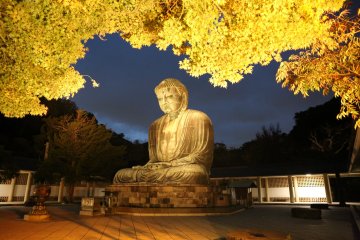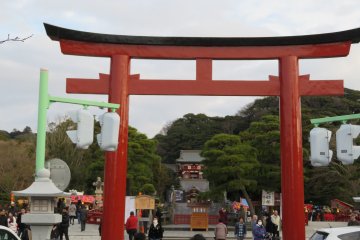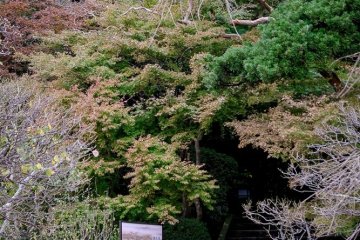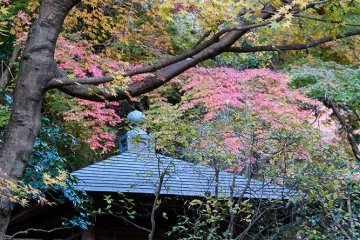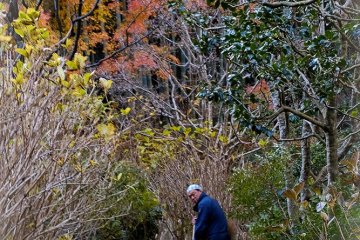Autumn in New York and Paris in the fall! These are great places to experience the changing colors of autumn as the seasons’ transition from summer to winter. While both cities (Bois de Boulogne and the Luxembourg Gardens in Paris, and Central Park in NYC) have spectacular fall foliage, I feel that Japan, too – and Kamakura in particular – has something very special to offer.
Four Distinct Seasons
In Japan, we have four very distinct seasons (five if you include the rainy season in June and July). The archipelago stretches from Okinawa in the south to Hokkaido in the north, a distance of some two thousand miles. Which means that you can still ski in April in parts of Hokkaido, while at the same time of year walk around in a pair of shorts and go swimming off the islands of Okinawa.
The same can be said of the foliage fronts that reflect the changing seasons. In the first weeks of March you are quite likely to see cherry blossoms (sakura) in bloom in southern Kyushu, while aficionados will oftentimes have to wait until early May to see the same species in flower in the country’s northernmost confines. The opposite occurs from October to December: the reds and yellows work their way south over a period of about ten weeks. Of course, there are variables, like altitude and geography, exposure to cold arctic winds and, conversely, warm southerly ones.
Blessed With a Mild Temperate Climate
In Kamakura, we are blessed with a mild temperate climate, slightly warmer than in Tokyo, which is less than one hour north by train: it is not surprising that Kamakura has been referred to as the “Riviera of the South”. While Tokyo has beautiful open spaces to view the autumn colors like Ueno Park, Yoyogi Park, and Shinjuku Gyoen, what we have in Kamakura is something truly spectacular.
Because mountains bound the city on three sides, it has a sheltered, secluded feel, which is precisely why the country’s first shogunate was established here in 1185. The more than one hundred and fifty temples and shrines, many of them World Heritage sites, that dot the wooded hillsides, stand out in perfect contrast to the mosaic of colors that the autumn weather brings with it.
From Cool Greens to Vibrant Reds and Yellows
As I write this article this third week of November, we are already beginning to see the cool greens of summer changing into the reds and yellows of autumn. The bamboo groves are turning a paler shade of green; the gingko trees, yellow; the persimmons are hanging delectably ripe and ready for the picking; and the autumn camellia (Camellia sasanqua) with its pretty pink flowers is waiting patiently to bloom. The momoji, the Japanese maple, and undoubtedly the star player in this colorful extravaganza, is hovering in the wings, ready to show off its vermillion and yellow ochre, and myriad shades in between. L’automne est arrive!
Grand Vistas and Hidden Corners
The best places to view the colors are some of the larger temples that have grand vistas as backdrops: Engakuji, Kenchoji, and Meigestsu-in in Kita-Kamakura, and Zuisenji and Hasedera in Kamakura proper. However, there are also smaller venues off the beaten track, less frequented by visitors, which are well worth a visit, particularly for their peace and tranquility, such as Kakuonji, Kaizoji, and Angkokuronji. There is also Genjiyama Park on the hilltop overlooking Sagami Bay.
The best time to visit Kamakura is from now until the third week of December, with the peak occurring during the last week of this month and the first two weeks of the next. I should also mention Egara Tenjinsha Jinja, a personal favorite, where the giant gingko tree, to the right of the shrine as you enter, has great historical and cultural significance. This magnificent tree is regarded by locals as the symbol of Kamakura, and somewhat as a guardian, because it was planted, and flourished, in the north-eastern corner of the shogunate, an area or direction that was considered spiritually vulnerable and was thus known at the time as the Demon’s Gate.
Beauty and Grandeur With a Sense of Aplomb
Japanese people are steeped in the beliefs of animism, which took root in the country long before the advent of Buddhism. Put in more mundane terms, they believe in the spiritual connect with inanimate objects - which is why you may find a prayer tied around a rock, a rope around a tree, or a solitary jizo located along a mountain path. Everything is imbued with a sense of awe and wonder — and destiny — which makes one feel that one belongs to something larger and more meaningful than just the human race.
Several years ago, in November 2016, we were fortunate enough to experience a couple of days of considerable snowfall. Snow on autumn leaves is a rare phenomenon in this part of the country. An elderly gentleman that I chanced upon during that snowstorm, in one of the temple grounds, remarked wistfully: “I will probably never again see such a sight in my lifetime…”
Red momiji leaves,
A far-off temple bell rings,
Lonely autumn’s here!
Come and experience for yourself the beauty and grandeur of this historical corner of Japan, as it shows off its amazing autumn colors - with aplomb! Kamakura is just a stone’s throw away (one hour by train) from Tokyo!




